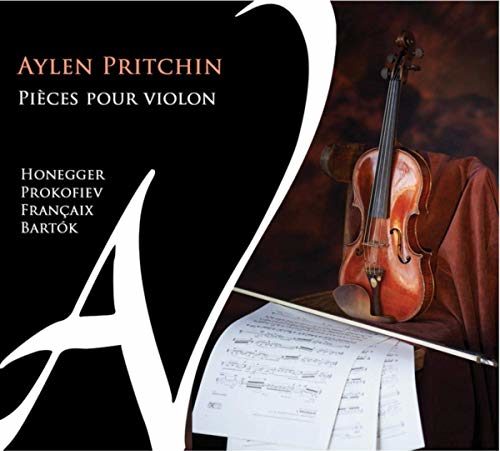 Релизы
Релизы
For his latest album Aylen Pritchin has chosen “the most important and significant works of the 20th century, written for solo violin”. This concept needs clarification. Historically, the violin was considered an instrument that depended on the support of an orchestra, ensemble or accompanist. Compositions, where the violinist would perform on their own were rare and unsystematic. However, the closer to the twentieth century, the more there were bold ideas about the “expansion” of tools, the disclosure of instruments’ full potential.
The booklet mentions that the purpose of this disc is to reflect “the most important and significant works of the 20th century for solo violin”. In the interview for the magazine “Musical Life” Pritchin said that the time period had significance for him. “In the 20th century, for various reasons, the genre of solo violin works has found a new life. The composers had a need to discover the violin’s new assets, to expand and overcome the capabilities of the instrument.”
The disc features solo sonatas by Prokofiev, Bartok, Honegger, as well as a Theme with eight variations by Jean Françaix. Out of these four compositions, Prokofiev’s Solo violin sonata op. 115 (1947) stands out as a “weak link.” It was written for teaching purposes for gifted students and was originally intended to be played by a group of students in unison. Therefore, the music reminds quite a bit of Paganini. It’s a set of educational and methodical formulas, sadly lacking that characteristic spark and sarcasm that Prokofiev’s music was famous for. Pritchin diplomatically noted that “while other composers were looking for new possibilities of the instrument for a more complex drama, for the sake of realizing a more profound concept, Prokofiev went in a completely different way,” and recognizes the “simplicity” of the music in the same interview. Indeed, his performance is just as simple and dry.
Bartok’s Solo violin sonata Sz. 117, BB 124 (1944) naturally continues the outlines of his Concerto for orchestra and Music for strings, percussion and celesta. Hungarian rhythms and intervals fill the first movement, written in the spirit of chaconne, though not using its structure. In the second movement, the violinist must clearly distinct the four voices of the Fugue, sounding in an assertive and aggressive manner. The third movement, “Melodia”, reflects the lyrical side of Bartok, a bright contrast with a rushing, restless finale. Pritchin’s performance reflects Bartok’s philosophical thoughts about the past and the future, perhaps inspired by World War II, which was going on at the time.
A different take on the art of violin music is provided by Jean Françaix’s Theme and eight variations (1980), a world’s first CD recording. This is a fully realized concert piece, which both demonstrates a wide range of violin techniques and invokes a wealth of images, funny and thoughtful. Of all the compositions, it is here that Pritchin is given a carte blanche for his bright and versatile talent.
The disc concludes with Honegger’s Sonata H. 143 (1940). Honegger was a composer better known for his orchestral works such as symphonies, Pacific 231, and the oratorio Jeanne d’Arc au bûcher. His creative thinking and desire to express the grandeur of orchestra in one instrument (sometimes even reminiscent of Bach’s Chaconne d-moll) has undoubtedly translated both into the music and into Pritchin’s interpretation.
Despite all the efforts of the artist, the very concept of the album is flawed, because the violin can’t entice the listener with the richness of registers and timbres that keyboard instruments possess. It is very difficult for the listener to bear the same timbre for more than an hour without a break, because inevitably there will be a sense of boredom and monotony. Even the fact that all compositions are divided into short movements or sections does not help the situation, because fundamentally the timbre of the violin can’t change as much as the whole orchestra or keyboard instruments. Therefore, listening to such a disc should be approached with caution, perhaps taking breaks between compositions; otherwise there is a risk to spoil the impression after the first ten minutes. If the listener likes this genre however, we recommend other solo violin CDs such as the anthology by Michael Barenboim, where the masters of the 18th century alternate with the modernists.
Unlike many other chamber recordings, this disc completely lacks reverberation, which would produce an ever so slightly audible echo. It feels like the soloist is in a small room right next to us. This approach creates a strong presence effect; however, the sound sometimes lacks saturation and depth. Talking about a production design, one should be befuddled with an extremely uninformative, short and for some reason anonymous booklet article, which might’ve as well not existed.
In general, Aylen Pritchin’s latest CD is an ambitious project which can cause a polar reaction from the audience, but certainly will not leave anyone indifferent.
Michael Krivitsky